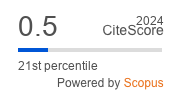Scroll to:
Letter to the Editor Regarding “Bone turnover markers in oral and gingival crevicular fluid in children with end-stage chronic kidney disease”
https://doi.org/10.47093/2218-7332.2025.16.2.28-29
We read the article by Elovskaya A. A. et al. regarding bone turnover markers in the oral and gingival crevicular fluid (GCF) in cases of end-stage chronic kidney disease (CKD) [1]. They evaluated 28 children with end-stage CKD from two groups; Group 1:14 cases with normal creatinine coefficient, Group 2:14 cases with kidney graft dysfunction (RTD) with creatinine coefficient > 25 ml/min/1.73 m². There was in addition a control Group comprising 20 children and adolescents, matched by sex and age to the CKD cases, with dental examination; bone turnover markers were tested in urine, blood, oral fluid (OF), and GCF [1]. The levels of osteocalcin (OC) were indicative of impaired bone mineralization in CKD-associated hyperparathyroidism; OC decrease in GCF was found in end-stage CKD and RTD compared with controls, while blood OC increase occurred only in end-stage CKD group, and OC in OF did not differ among groups [1]. The authors suggested more longitudinal studies and large samples to clear the bone changes of end-stage CKD and RTD children.
The following brief comments on several studies from the last two years aim to emphasise the importance of the topic under discussion and to maintain the interest of healthcare workers. These concern the cornerstone clues to be utilized for diagnosis and the patient’s management. Foroughi M. et al. reviewed the relationships between periodontal disease and systemic health conditions, including the pathogenesis biomarkers, diagnostic advances, and management [2]. Elevated levels in GCF of receptor activator of nuclear factor kappa-Β ligand (RANKL), osteoprotegerin (OPG), and matrix metalloproteinases are markers of high bone resorption; and RANKL-to-OPG ratio is an important marker of bone turnover in the periodontal region [2]. The authors highlighted the more recent advanced tools for diagnosing periodontal disease, favoring the early accurate systemic risk assessment, with reduced limitations in terms of cost and accessibility, as well as integration of the more effective innovations into routine clinical practice [2]. Furthermore, the standardization of respective guidelines for biomarker measurement and data interpretation will also be needed for introducing these markers among daily procedures [2]. Hu S. et al. measured the levels of neutrophil extracellular traps (NETs) in patients with CKD and periodontitis, to evaluate the relationship between NETs, and these two disorders [3]. Among the participants, 63 were CKD and 40 non-CKD individuals who underwent periodontal examination, and 35 early CKD patients underwent periodontal therapy. CKD patients had higher levels of NETs in plasma than the non-CKD group. NETs levels were also higher in GCF and plasma of patients with periodontitis [3]. The authors concluded that NETs could represent an eventual paper bridging the periodontitis process and the CKD, and would be a practical potential target for the therapy [3]. Matsuoka M. et al. reviewed the literature on immune responses occurring in the oral cavity and involving the saliva and GCF roles in the maintenance of local and systemic health. As well as this, they focused on the potential contributions of GCF as a useful innovative diagnostic tool [4]. They suggested further research on the GCF components in order to make the study more comprehensive.
Conflict of interests. The authors declare that there is no conflict of interests.
Конфликт интересов. Авторы заявляют об отсутствии конфликта интересов.
References
1. Elovskaya A.A., Maslikova E.A., Morozova N.S., et al. Bone turnover markers in oral and gingival crevicular fluid in children with end-stage chronic kidney disease. Sechenov Med J. 2025 May; 16(1): 34–44 (In Russian). https://doi.org/10.47093/2218-7332.2025.16.1.34-44. Epub 2025 May 24. EDN: CENYNS
2. Foroughi M., Torabinejad M., Angelov N., et al. Bridging oral and systemic health: exploring pathogenesis, biomarkers, and diagnostic innovations in periodontal disease. Infection. 2025 May 26. https://doi.org/10.1007/s15010-025-02568-y. Epub ahead of print. PMID: 40418274
3. Hu S., Yang R., Yang W., et al. Neutrophil extracellular traps in the cross-talk between periodontitis and chronic kidney disease. BMC Oral Health. 2024 Nov 8; 24(1): 1357. https://doi.org/10.1186/s12903-024-05071-2. PMID: 39516827
4. Matsuoka M., Soria S.A., Pires J.R., et al. Natural and induced immune responses in oral cavity and saliva. BMC Immunol. 2025 Apr 18; 26(1): 34. https://doi.org/10.1186/s12865-025-00713-8. PMID: 40251519
About the Authors
V. M. dos SantosBrazil
Vitorino M. dos Santos, MD, PhD, Adjunct-Professor, Department of Medicine
01, QS 07, Taguatinga Sul, Brasília, 71966-700
Estrada do Contorno do Bosque S/N, Cruzeiro Novo, 70658-900, Brasília-DF
K. M. Sugai
Brazil
Kin M. Sugai, Student of Postgraduate Course of Management, Technology, and Information Security
Darcy Ribeiro Campus, Asa Norte, Brasília, 70910-900







































